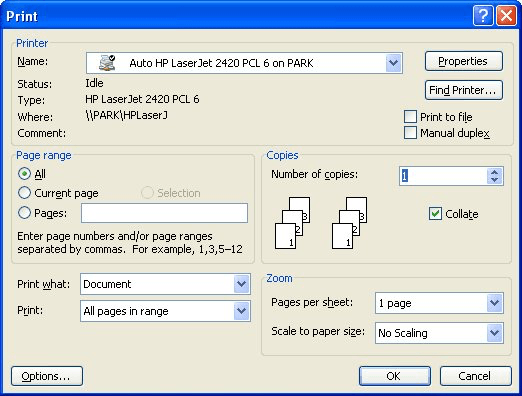Please Note: This article is written for users of the following Microsoft Word versions: 2000, 2002, and 2003. If you are using a later version (Word 2007 or later), this tip may not work for you. For a version of this tip written specifically for later versions of Word, click here: Scaling Your Output.
Written by Allen Wyatt (last updated December 19, 2020)
This tip applies to Word 2000, 2002, and 2003
You have been working on your document for hours. It is 35 pages long, and designed to be printed on legal-size paper. You decide to print the document, and discover you are out of legal paper. What do you do if you can't get any legal paper right away? You could reformat the document for letter-size paper, but that may not be the best solution.
Fortunately, Word includes a feature that allows you to independently specify a target paper size and an output paper size. This means you can format something for legal size, but instruct Word to scale the output so it will fit on letter size. This is very similar to a reduction setting on a copier. To take advantage of this feature, follow these steps:

Figure 1. The Print dialog box.
You should note that this scaling feature was introduced in Word 2000, so it is not available in Word 97.
WordTips is your source for cost-effective Microsoft Word training. (Microsoft Word is the most popular word processing software in the world.) This tip (1832) applies to Microsoft Word 2000, 2002, and 2003. You can find a version of this tip for the ribbon interface of Word (Word 2007 and later) here: Scaling Your Output.

Discover the Power of Microsoft Office This beginner-friendly guide reveals the expert tips and strategies you need to skyrocket your productivity and use Office 365 like a pro. Mastering software like Word, Excel, and PowerPoint is essential to be more efficient and advance your career. Simple lessons guide you through every step, providing the knowledge you need to get started. Check out Microsoft Office 365 For Beginners today!
Tired of your page borders not printing out as you expect? The problem could be due to any number of settings or ...
Discover MoreDo you want to transfer fonts from one computer system to another? It is relatively easy to do, but there is one ...
Discover MoreEndnotes are easy enough to add and accumulate in a document. For this reason, Word makes it easy to jump from one ...
Discover MoreFREE SERVICE: Get tips like this every week in WordTips, a free productivity newsletter. Enter your address and click "Subscribe."
There are currently no comments for this tip. (Be the first to leave your comment—just use the simple form above!)
Got a version of Word that uses the menu interface (Word 97, Word 2000, Word 2002, or Word 2003)? This site is for you! If you use a later version of Word, visit our WordTips site focusing on the ribbon interface.
Visit the WordTips channel on YouTube
FREE SERVICE: Get tips like this every week in WordTips, a free productivity newsletter. Enter your address and click "Subscribe."
Copyright © 2025 Sharon Parq Associates, Inc.
Comments